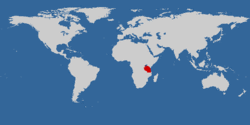Housing
White eye-rings lovebirds, of which masked lovebirds are part, are reportedly less aggressive in comparison to the slightly larger peach-faced lovebird. They are frequently housed in aviaries with other species of their genus, a practice which although can be convenient, and wonderfully aesthetic, may lead to hybridization. This can especially be concerning where other species may not be as locally common e.g. black-cheeked lovebird and Lilian's lovebird. It may be advisable to house lovebirds either by themselves, or if a mixed collection is desired, ensure they are kept in a large flight with a few feeding stations, and assertive species e.g. red-rumped parrot, kākāriki, rose-ringed parakeet or cockatiels. They can usually be kept safely with quails and pheasants in aviaries.
Breeding cages should be 400mm x 400mm x 500mm, or these birds can be housed in colonies, or have in some cases been "kept at liberty". There was a mixed flock of masked, peach-faced lovebird, and a few hybrids near Napier, New Zealand for a number of years in the mid-2000s. There is also a small feral population in France, which contains the Blue mutant, and mixes with larger proportion of Fischer's lovebirds - also from aviary origin.
Aviaries, and cages need perches in a range of diameters. Natural perches in the form of branches are ideal, especially if they have a variety of forks, angles, and a bit of bounce in them. The reason for this is to give the captives stimuli; it also keeps their feet healthy, and nimble. Research (suitability, and toxicity) must be carried out on all plant material going into any cages. Cherry wood is poisonous, as is broom, kōwhai, and avocado (its fruit being surprisingly poisonous to parrots), to mention just a few examples.
Nesting boxes are usually utilised throughout the year as sleeping quarters. It is advisable to clean them, but keep them up even after breeding season. The risk of losing a bird to egg laying complications (in the unlikely event they do decide to breed in the winter), is out-weighed by the benefit of keeping the birds content, keeping pair-bonds strong, and the reduced risk of losing a bird to the cold. A supply of willow branches and roughly slivered corn or maize husk can be given in the aviary as nesting box lining: it will be ripped up and carried into the nest box by the female.
Lovebirds are reasonably difficult to sex. A "pair" will often be of the same sex, even though they are exhibiting signs of mutual affection. This usually arises when inexperienced bird keepers house two birds alone, and wait on behavioral signs that they're a "true pair", with the intention of swapping one out for another lovebird if they're not, then becoming excited when they see birds "pair up", even though they may both be of the same sex. These bonds are artificial and can be broken, or tested if the "pair" are re-housed communally (or split up by the keeper). One or both of a pair of males may go, and breed with lone hens, despite staying connected to their original partner. Alternatively, the same sex pair's bond may completely dissolve immediately.
Colour varieties
The blue mutation was originally found in wild birds in the 1920s and is the oldest colour mutation known in the lovebird genus. [5] [7] The other mutations are a result of selective breeding in aviculture, such as two cobalts which will make a mauve (black). [5] Various colour mutations exist, including blue, cobalt, mauve, slate, diluted slate, violet, lutino and albino.
The blue and the lutino mutations are where some colour genes have not been passed on, or have been suppressed from the original wild colour form. In the case of the lutino, the micro-structure which creates the blue based colours in the normal form is not passed on to offspring when it arises; hence, the parrot is orange around its face and yellow everywhere else. In the case of the original blue, none of the yellow or red pigment genes are passed on. The albino is the latest "colour" which is a combination of the lutino and the blue ("wild" colouring minus blue, red and yellow results in no colour, so it is completely white).
The dilute mutation is a lightening of the darker feathers, most noticeable in the wings, and face. It was first noted from green (wild) coloured parents, and originally called "yellow". This new colour was soon built up in numbers by passionate aviculturelists, and once secure was bred to blue coloured birds. The result was then known as "white", but it is now called "dilute blue".











